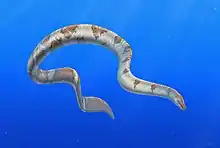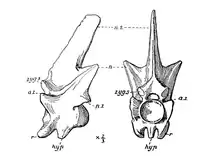| Pterosphenus Temporal range: | |
|---|---|
 | |
| Life restoration of Pterosphenus | |
| Scientific classification | |
| Domain: | Eukaryota |
| Kingdom: | Animalia |
| Phylum: | Chordata |
| Class: | Reptilia |
| Order: | Squamata |
| Suborder: | Serpentes |
| Family: | †Palaeophiidae |
| Subfamily: | †Palaeophiinae |
| Genus: | †Pterosphenus Lucas, 1898 |
| Type species | |
| †Pterosphenus schucherti Lucas, 1898 | |
| Species | |
| |
| Synonyms | |
| |

Pterosphenus is an extinct genus of marine snake of the Eocene period.[1][2]
Classification
Pterosphenus belong to the Alethinophidia snakes, a clade which includes all snakes outside of blind and thread snakes, and more specifically to the extinct Palaeophiidae. Its closest relative is Palaeophis, of which both belong to the subfamily Palaeophiinae. Five species are known, P. schucherti from North America, P. sheppardi from South America, P. schweinfurthi from northern Africa and P. biswasi, and P. kutchensis from Asia.
Description
While only known from partial remains, enough has been found of Pterosphenus to suggest it was a large reptile. Based on the regression model used to estimate the length of boids, the most reliable length estimate lies between 2.5 and 4.8 metres (8.2 and 15.7 ft); the largest vertebra may have belonged to an individual reaching 5.7 metres (19 ft) in length.[3] Its body was strongly laterally compressed as an adaptation to pelagic life.

Palaeoenvironment and Palaeoecology
A marine ocean dweller, Pterosphenus lived in the shallow seas of the future eastern US (fossils are known from Texas, Louisiana, Mississippi, and Arkansas and up north to New Jersey), Africa in the Tethys Ocean (fossils are known from Morocco,[4] Libya,[5] Nigeria,[6] and Egypt[7]), South America (fossils are known from Ecuador[8]) and southern Asia (fossils are known from India[9]). Pterosphenus was a top predator of the ecosystem, likely preying on fish and molluscs found in the same area.
It is certain that Pterosphenus would have encountered basal cetaceans of the time like Zygorhiza, Dorudon, and Basilosaurus, though its likely a mixed of niche partitioning and living in different areas in the case of Basilosaurus (which lived in estuary ecosystems according to recent finds) would prevent competition between the species.
References
- ↑ Case, Dennis; Parmley, Gerard (September 23, 1988). "New records of Eocene sea snakes (Pterosphenus) from Louisiana". Journal of Vertebrate Paleontology. 8: 334–339. JSTOR 4523211.
- ↑ Westgate, Jim F.; Ward, James. W. (1981). "The giant aquatic snake Pterosphenus schucherti (Palaeophidae) in Arkansas and Mississippi". Journal of Vertebrate Paleontology. 1 (2): 161–164. doi:10.1080/02724634.1981.10011887.
- ↑ Calvert, C.J.; Mead, A.J.; Parmley, D. (2022). "Size Estimates of the Extinct Marine Snake Pterosphenus schucherti from Eocene-aged Sediments of Central Georgia". Georgia Journal of Science. 80 (2). ISSN 0147-9369.
- ↑ Zouhri, Samir; Gingerich, Philip D.; Elboudali, Najia; Sebti, Samira; Noubhani, Abdelmajid; Rahali, Meriem; Meslouh, Saïd (2014). "New marine mammal faunas (Cetacea and Sirenia) and sea level change in the Samlat Formation, Upper Eocene, near Ad-Dakhla in southwestern Morocco". Comptes Rendus Palevol. 13 (7): 599–610. doi:10.1016/j.crpv.2014.04.002.
- ↑ Hoffstetter, R. (1961). "Nouvelles récoltes de serpents fossiles dans l'Éocène Supérieur du désert Libyque". Bulletin du Muséum national d'histoire naturelle. 2e série. 33 (3): 326–331.
- ↑ Georgalis, Georgios L. (2023-06-19). "First potential occurrence of the large aquatic snake Pterosphenus (Serpentes, Palaeophiidae) from Nigeria, with further documentation of Pterosphenus schweinfurthi from Egypt". Alcheringa: An Australasian Journal of Palaeontology: 1–9. doi:10.1080/03115518.2023.2217874. ISSN 0311-5518.
- ↑ Seiffert, Erik R.; Simons, Elwyn L.; Attia, Yousry (2003). "Fossil evidence for an ancient divergence of lorises and galagos". Nature. 422 (6930): 421–424. Bibcode:2003Natur.422..421S. doi:10.1038/nature01489. PMID 12660781. S2CID 4408626.
- ↑ Hoffstetter, Robert (1958-01-01). "Un serpent marin du genre Pterosphenus (Pt. sheppardi nov. sp.) dans l'Eocene superieur de l'Equateur (Amerique du Sud)". Bulletin de la Société Géologique de France. S6-VIII (1): 45–50. doi:10.2113/gssgfbull.S6-VIII.1.45. ISSN 0037-9409.
- ↑ Rage, Jean-Claude; Bajpai, Sunil; Thewissen, Johannes G. M.; Tiwari, Brahma N. (2003). "Early Eocene snakes from Kutch, Western India, with a review of the Palaeophiidae". Geodiversitas. 25 (4): 695–716 – via ResearchGate.